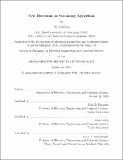New directions in streaming algorithms
Author(s)
Vakilian, Ali.
Download1142633610-MIT.pdf (3.082Mb)
Other Contributors
Massachusetts Institute of Technology. Department of Electrical Engineering and Computer Science.
Advisor
Erik D. Demaine and Piotr Indyk.
Terms of use
Metadata
Show full item recordAbstract
Large volumes of available data have led to the emergence of new computational models for data analysis. One such model is captured by the notion of streaming algorithms: given a sequence of N items, the goal is to compute the value of a given function of the input items by a small number of passes and using a sublinear amount of space in N. Streaming algorithms have applications in many areas such as networking and large scale machine learning. Despite a huge amount of work on this area over the last two decades, there are multiple aspects of streaming algorithms that remained poorly understood, such as (a) streaming algorithms for combinatorial optimization problems and (b) incorporating modern machine learning techniques in the design of streaming algorithms. In the first part of this thesis, we will describe (essentially) optimal streaming algorithms for set cover and maximum coverage, two classic problems in combinatorial optimization. Next, in the second part, we will show how to augment classic streaming algorithms of the frequency estimation and low-rank approximation problems with machine learning oracles in order to improve their space-accuracy tradeoffs. The new algorithms combine the benefits of machine learning with the formal guarantees available through algorithm design theory.
Description
This electronic version was submitted by the student author. The certified thesis is available in the Institute Archives and Special Collections. Thesis: Ph. D., Massachusetts Institute of Technology, Department of Electrical Engineering and Computer Science, 2019 Cataloged from student-submitted PDF version of thesis. Includes bibliographical references (pages 233-246).
Date issued
2019Department
Massachusetts Institute of Technology. Department of Electrical Engineering and Computer SciencePublisher
Massachusetts Institute of Technology
Keywords
Electrical Engineering and Computer Science.